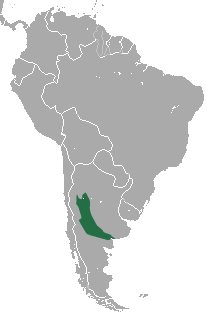Pink fairy armadillo
| Pink fairy armadillo[1] | |
|---|---|

| |
| Scientific classification | |
| Kingdom: | |
| Phylum: | |
| Class: | |
| Superorder: | |
| Order: | |
| Family: | |
| Subfamily: | |
| Genus: | Chlamyphorus
|
| Binomial name | |
| Chlamyphorus truncatus | |

| |
| Pink fairy armadillo range | |
The pink fairy armadillo (Chlamyphorus truncatus) or pichiciego is the smallest species of armadillo. It is found in central Argentina where it lives in dry grasslands and sandy plains.
The armadillo's body is 84–117 mm long and its tail is 27-35 mm long. They usually weigh 85 grams. Their armor is a pale pink, and their legs are covered with little white hairs.[3] There is not enough information to say whether it is an endangered species.
About
[change | change source]The pink fairy armadillo, scientifically know as the Chlamyphorus truncatus, is the smallest living armadillo and one of the least-known burrowing mammals.[4] They are native to central Argentina and are distinguished by their carapace consisting of hardened scales and osteoderms. Additionally, its skin and shell possess distinct features not found in other armadillos. This species exhibits predominantly subterranean behavior, which is a rare trait among burrowing mammals.[5] This differentiation is important because it shows that they the specific skin under their shield suggests biomechanics adaptions, such as advancements in the displacement through the tunnels of sandy soils.
In that environment, the diminutive, pink-hued creature burrows in search of insects, its primary food source. It displays remarkable excavation abilities, swiftly hiding itself from predators like foxes and owls by completely burying itself in a matter of seconds.[6] Its carapace is multi-purposed used for protecting and shielding itself from predators, in addition to allowing it to move efficiently underground.
- ↑ Gardner, A. (2005). Wilson, D. E.; Reeder, D. M (eds.). Mammal Species of the World (3rd ed.). Johns Hopkins University Press. p. 96. ISBN 978-0-8018-8221-0. OCLC 62265494.
- ↑ "Chlamyphorus truncatus". IUCN Red List of Threatened Species. Version 2011.1. International Union for Conservation of Nature. 2009. Retrieved 4 October 2011.
- ↑ Nowak, Ronald (1999). Ronald Nowak (ed.). Walker's mammals of the world. Vol. 1 (illustrated ed.). JHU Press. p. 166. ISBN 0801857899.
- ↑ Basso, Ana P.; Sidorkewicj, Nora S.; Casanave, Emma B.; Mason, Matthew J. (2020-05). "The middle ear of the pink fairy armadillo Chlamyphorus truncatus (Xenarthra, Cingulata, Chlamyphoridae): comparison with armadillo relatives using computed tomography". Journal of Anatomy. 236 (5): 809–826. doi:10.1111/joa.13146. ISSN 0021-8782. PMC 7163662. PMID 31997377.
{{cite journal}}: Check date values in:|date=(help)CS1 maint: PMC format (link) - ↑ Krmpotic, C. M.; Scarano, A. C.; Andrés Laube, P. F.; Ciancio, M. R.; Loza, C. M.; Acuña, F.; Castro, N. N.; Barbeito, C. G. (2023-12-19). "The double skin of the pink fairy armadillo, the peculiar integumentary system of Chlamyphorus truncatus Cingulata (Mammalia, Xenarthra)". Journal of Zoology. doi:10.1111/jzo.13136. ISSN 0952-8369.
- ↑ Lyonnet, J (April 2023). "Call for protection of ill-starred armadillo species". EcoAméricas.

